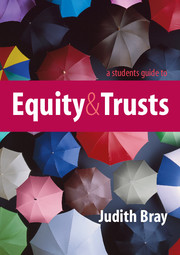Book contents
- Frontmatter
- Contents
- Preface
- 1 Historical introduction
- 2 Equitable remedies
- 3 The classification of trusts and powers
- 4 The three certainties
- 5 Constitution of trusts
- 6 Formalities for the creation of a trust
- 7 Private purpose trusts
- 8 Unincorporated associations
- 9 Resulting trusts
- 10 Constructive trusts
- 11 Trusts of the family home
- 12 Secret trusts and mutual wills
- 13 Charities; the Charities Act and the rules of cy près
- 14 Trustees: appointment, retirement and capacity
- 15 Duties and powers of trustees
- 16 Variation of trusts
- 17 Fiduciary duties and breach of fiduciary duties
- 18 Breach of trust and defences to breach of trust
- 19 Remedies against strangers to a trust
- 20 Tracing
- Index
3 - The classification of trusts and powers
- Frontmatter
- Contents
- Preface
- 1 Historical introduction
- 2 Equitable remedies
- 3 The classification of trusts and powers
- 4 The three certainties
- 5 Constitution of trusts
- 6 Formalities for the creation of a trust
- 7 Private purpose trusts
- 8 Unincorporated associations
- 9 Resulting trusts
- 10 Constructive trusts
- 11 Trusts of the family home
- 12 Secret trusts and mutual wills
- 13 Charities; the Charities Act and the rules of cy près
- 14 Trustees: appointment, retirement and capacity
- 15 Duties and powers of trustees
- 16 Variation of trusts
- 17 Fiduciary duties and breach of fiduciary duties
- 18 Breach of trust and defences to breach of trust
- 19 Remedies against strangers to a trust
- 20 Tracing
- Index
Summary
Key points
a trust is an imperative obligation;
trusts can arise either expressly or impliedly;
an express trust can take effect as a bare trust or a fixed trust or a discretionary trust;
a fixed trust arises where the beneficiaries have clearly identifiable interests in the trust property;
a discretionary trust allows the trustees to choose from a group of beneficiaries who should benefit under the trust;
a power is discretionary and the donee can choose whether or not to make an appointment;
powers of appointment include bare powers and fiduciary powers;
if a power of appointment is not exercised, the property will revert to the settlor’s estate unless there is a gift over in default of appointment or a gift is implied in favour of all the objects;
the court can intervene where the donee of the power exercises it fraudulently;
a trust can be clearly distinguished from other legal concepts such as a debt, agency, bailment and a gift although there are also similarities; and
trusts are used today for a wide variety of reasons including pension schemes, investment schemes, charities, ownership of land and protective trusts.
Differences between a trust and a power
A trust imposes an imperative obligation on the trustee. This means that the trustee must carry out the wishes of the settlor. The trustee has no choice whether or not to act. If the trustee cannot act or refuses to act, the court can replace the trustee or step in and carry out the wishes of the trustee itself. A power of appointment is fundamentally different because the donee of a power has a discretion whether to act or not. No action can be brought if the power of appointment is not exercised, whereas the beneficiaries of a trust can bring an action whenever a trustee fails to act. There are similarities between the two and there may be a power imposed over a trust fund so the trustees act in both capacities. A power may be created where the donor wishes to allow the donee the right to choose among a group who is to benefit but does not wish the donee to carry all the responsibilities associated with trusteeship.
- Type
- Chapter
- Information
- A Student's Guide to Equity and Trusts , pp. 32 - 46Publisher: Cambridge University PressPrint publication year: 2012



